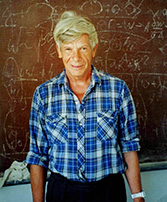Speaker
Description
A phenomenological description of the process of particle production is explored on the example of the action of an ideal fluid with a variable number of particles. The Euler formalism is used because it allows to include the continuity equation in the matter action explicitly through a corresponding constraint. To pass to a model with a variable number of particles, it suffices to replace the aforementioned constraint with the particle creation law that contains the function $\Phi$ which depends on the invariants of the fields responsible for the creation process as a source. The left-hand side of the particle creation law multiplied by $\sqrt{|g|}$ is a conformal invariant so the term $\Phi\,\sqrt{|g|}$ is also a conformal invariant. Particles are born exclusively due to vacuum polarization, which is due to the influence of the gravitational field in the absence of classical external fields so $\Phi$ should depend solely on geometric invariants. The square of the Weyl tensor is the only option if we confine ourselves to invariants that are at most quadratic in the curvature tensor. This result is universal for Riemannian geometry regardless of the gravitational Lagrangian and it also takes into account the back reaction. Of particular physical interest is the situation where the possibility of particle production exists but is not realized. This is the so-called "pregnant vacuum", which is an example of a physical vacuum. It corresponds to the solution of the motion equations for which the number density and, as a consequence, the function $\Phi$ are zero. It is shown that in this case the matter that can potentially be born has a non-zero pressure. For spherically symmetric geometries in the absence of external fields the condition $\Phi=0$ leads to the fact that the two-dimensional scalar curvature $\widetilde{R}$ equals to 2. In this case, the momentum energy tensor obtained from the matter action is proportional to the Bach tensor and turns out to be zero. It is demonstrated that in general relativity in the absence of external fields there are no spherically symmetric vacuum solutions of the black hole type, which correspond to the physical vacuum for the action in question. The same is true for quadratic gravity if we restrict ourselves to static spacetimes with scalar curvature sufficiently quickly approaching a constant at spatial infinity. When an external scalar field is introduced into the particle creation law, the following combination is chosen: $\varphi \, \varphi^{;a}_{;a}-\frac{1}{6}\, \varphi^{2}\, R+\Lambda_0\, \varphi ^{4}$, since it gives a nontrivial motion equation and is conformally invariant when multiplied by $\sqrt{|g|}$. It is shown that in general relativity the physical vacuum in the spherically symmetric case cannot be the Schwarzschild-de Sitter metric even with the addition of a scalar field.

